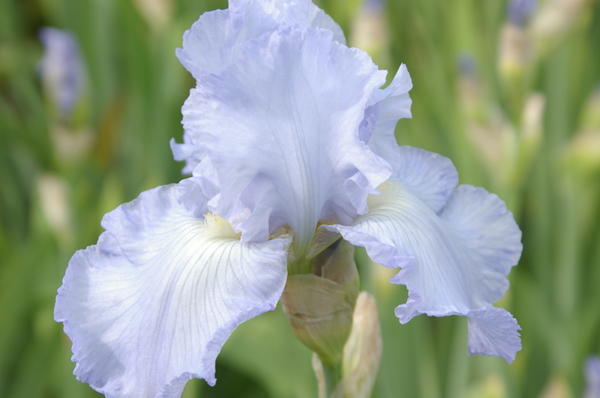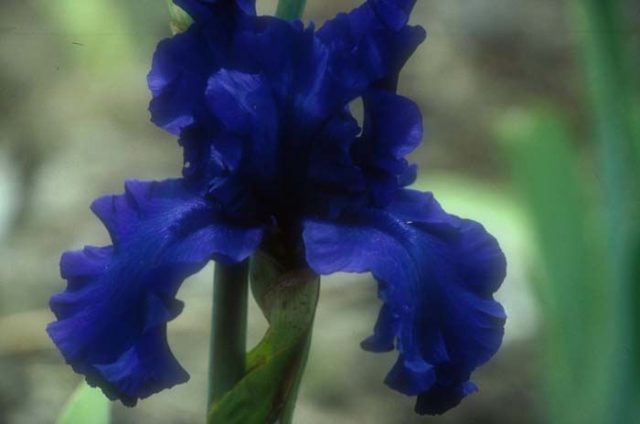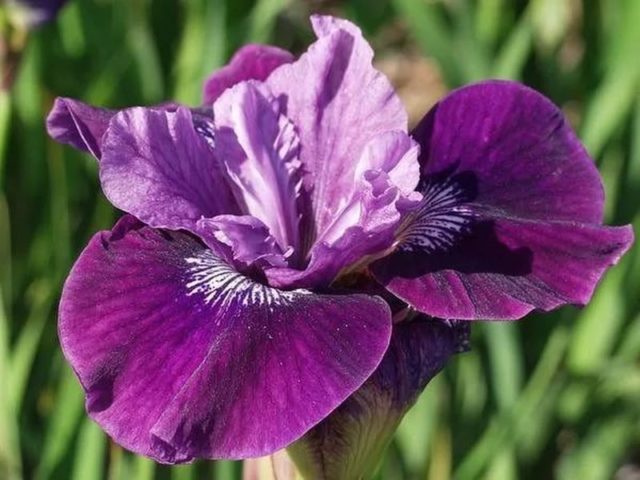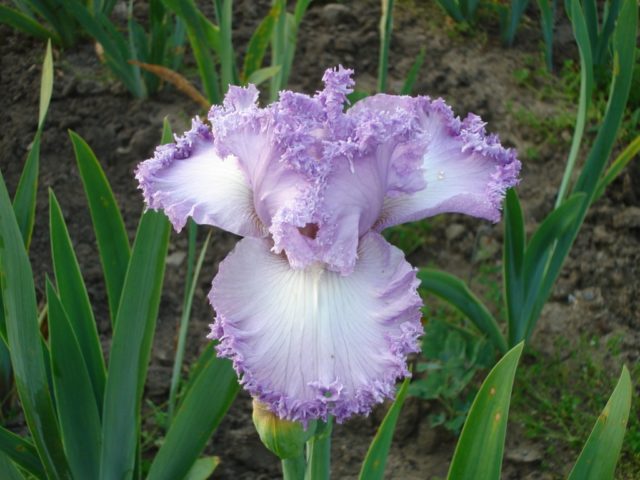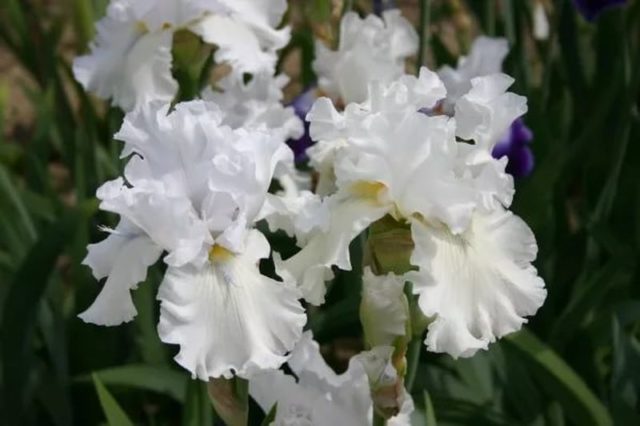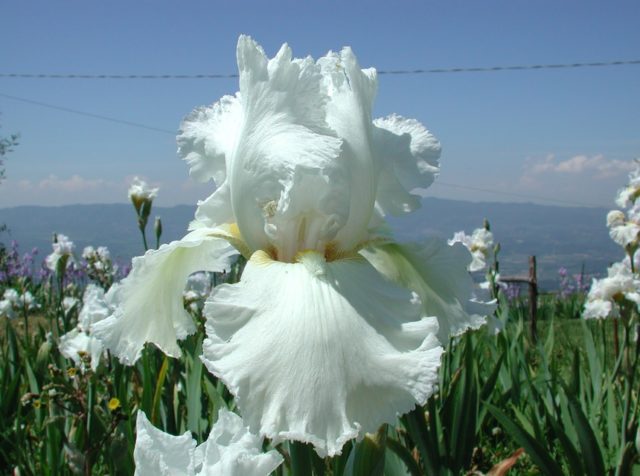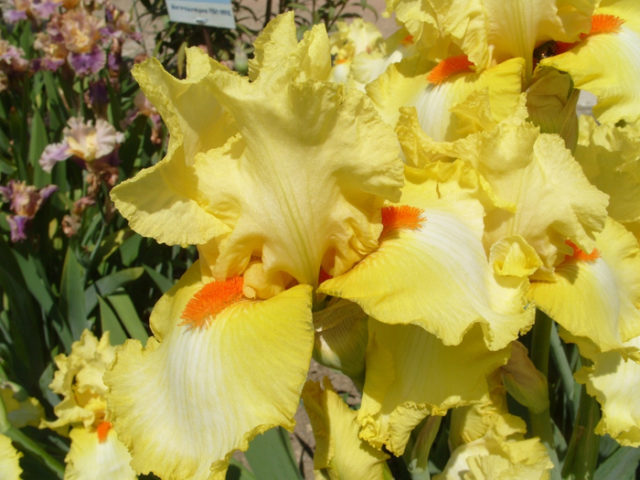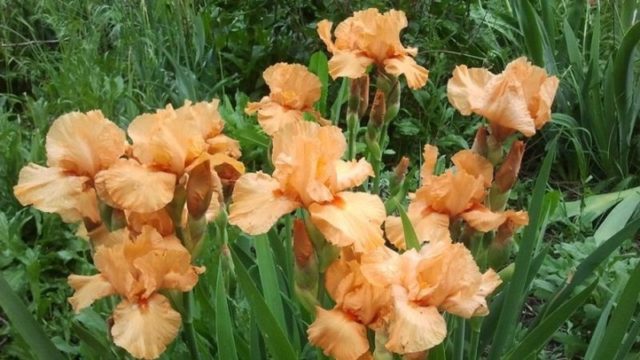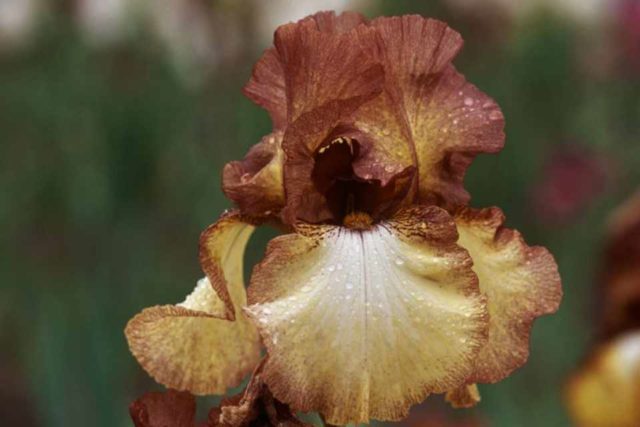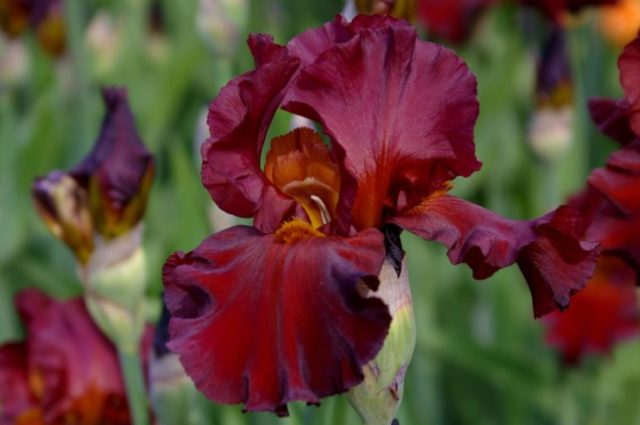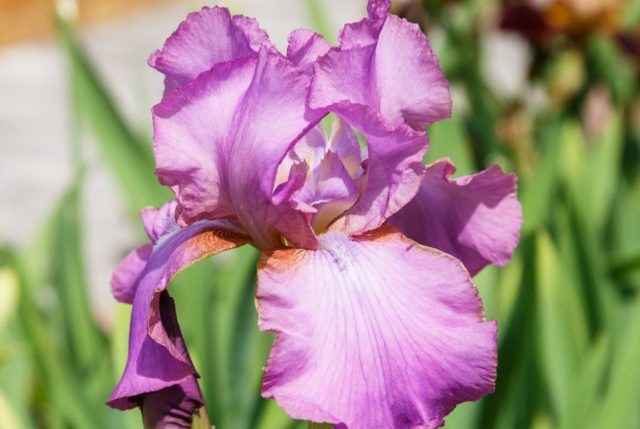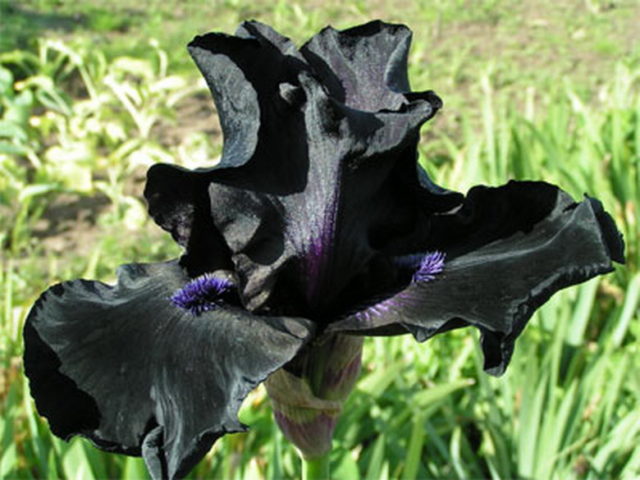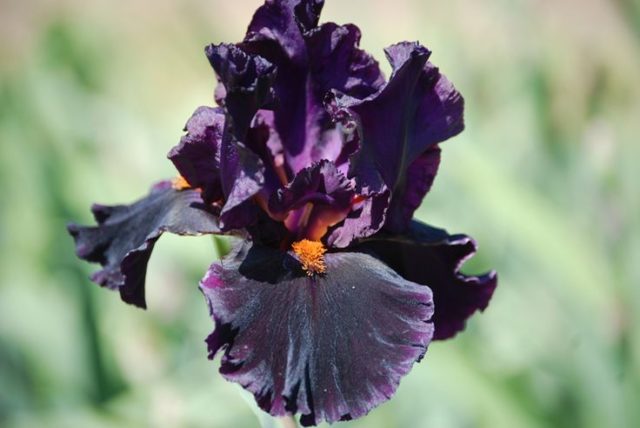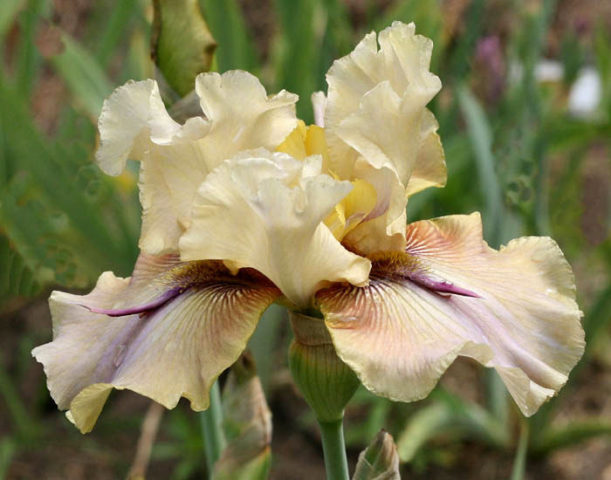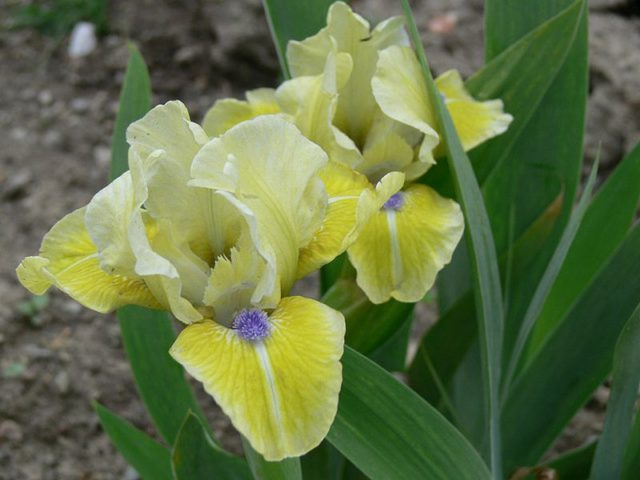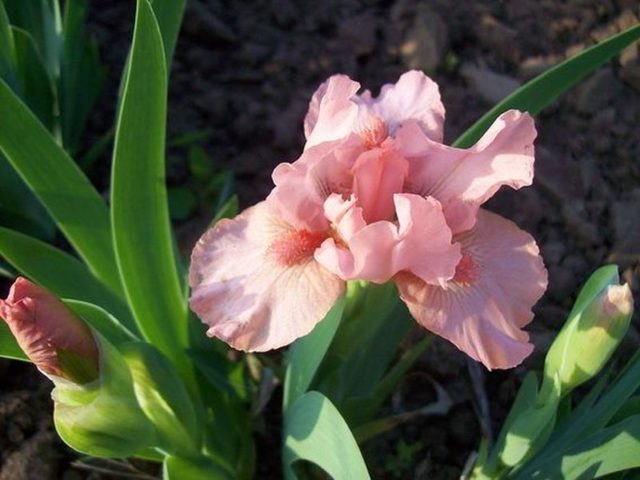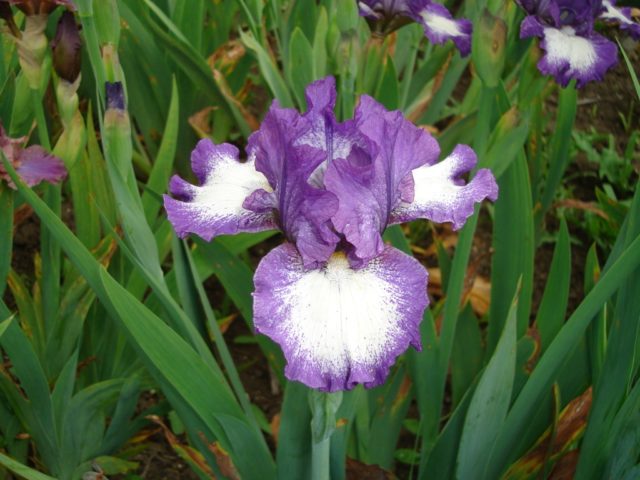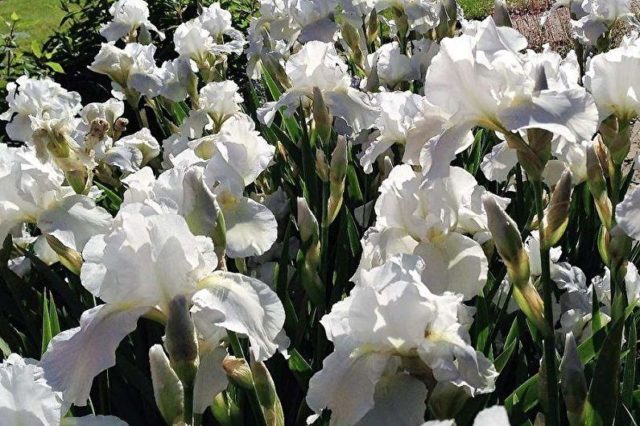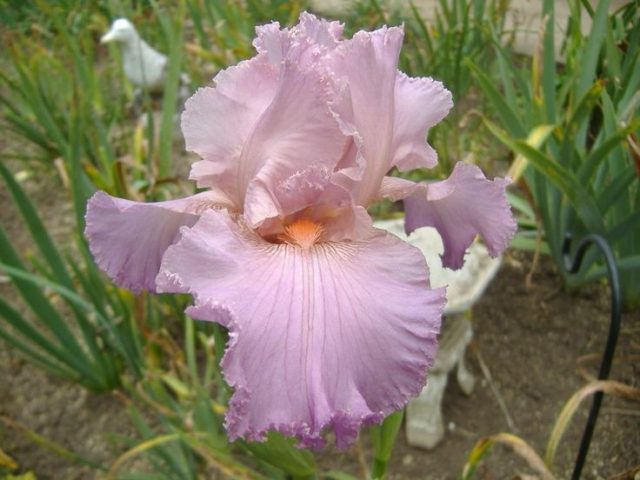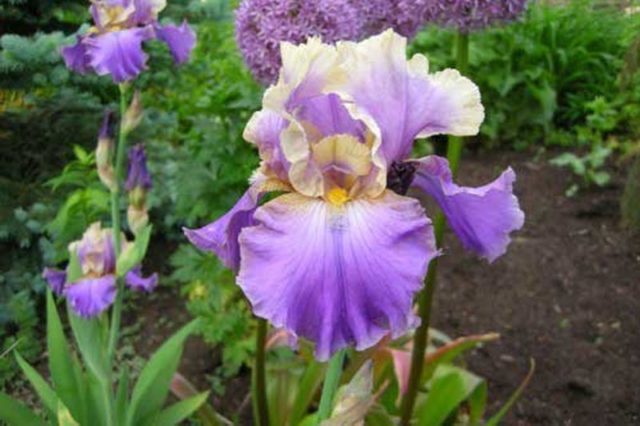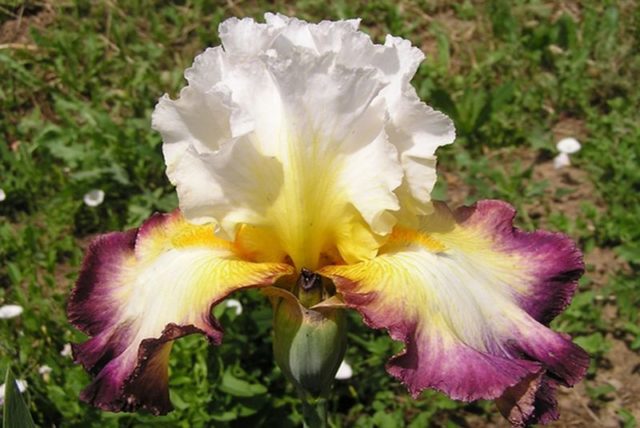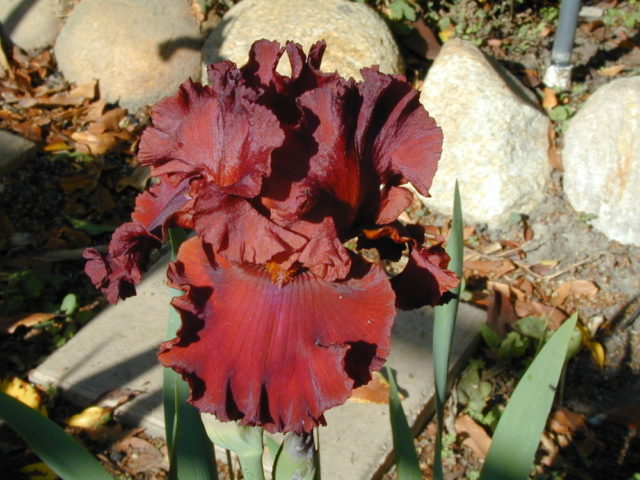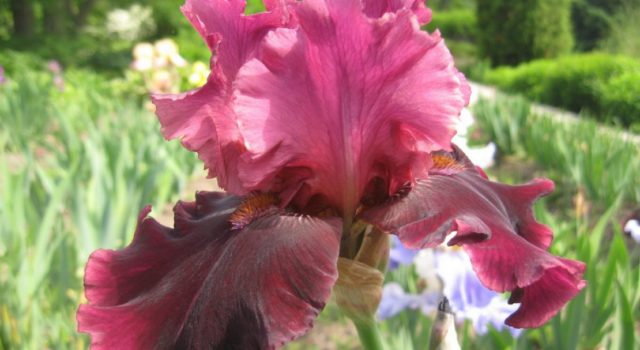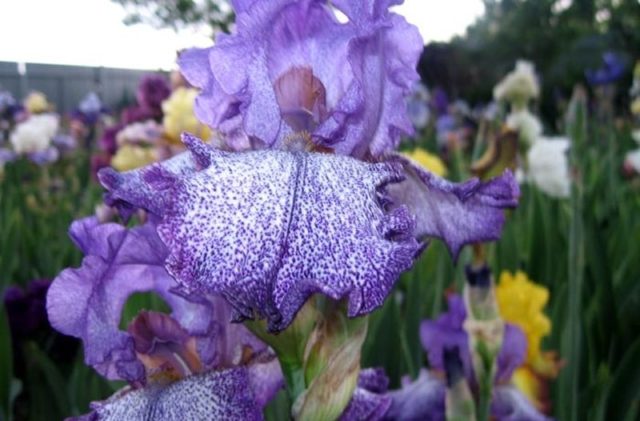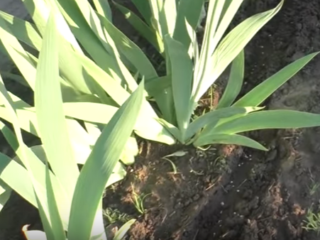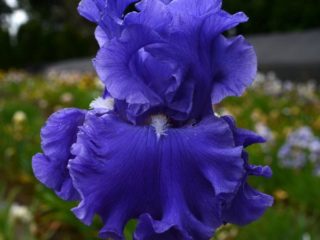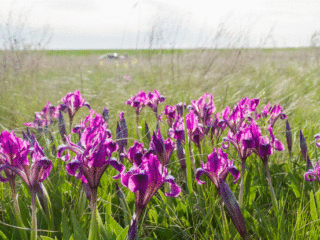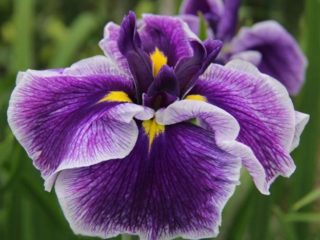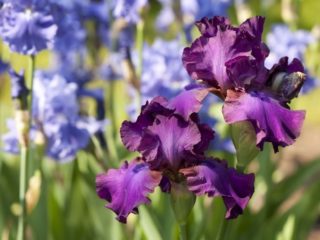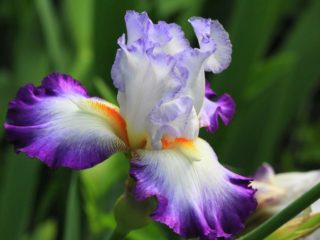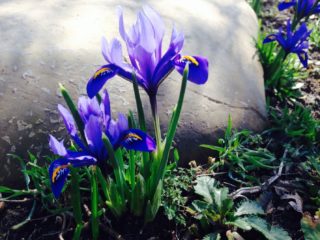Content
Photos of irises of all varieties allow you to appreciate the huge variety of perennials. Among the types of crops there are tall and miniature, monochromatic and bicolor, light and bright plants.
What types of irises are there?
Photos of varieties of iris flowers show countless perennials. First of all, they can be divided into 2 large groups - bearded, with a pubescent stripe-petal, and beardless. In addition, flowers are usually classified:
- by shades;
- by country of origin;
- by height.
Irises can also be classified into different groups based on the type of underground part - some have a rhizome, others grow from a bulb.
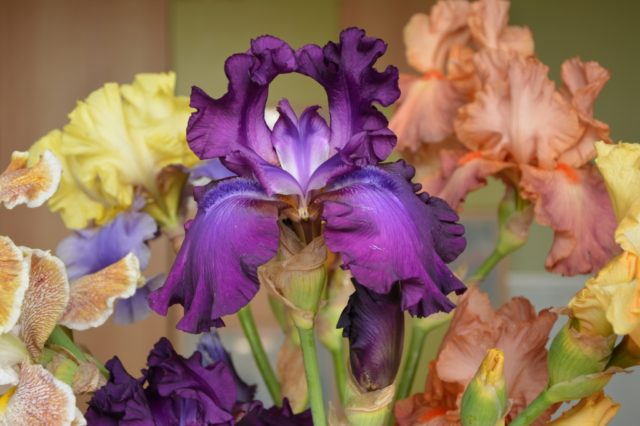
Blooming irises are represented in all existing shades
Bearded
Among the types of irises with photos and names, bearded plants are of particular interest; they are the most beautiful. They reach an average of 25-70 cm in height and bear large buds with a characteristic beard and a pubescent stripe on the outer petals. The leaves of the bearded iris are lanceolate and long, and the flowers often have decorative frills, curls, or contrasting borders. One inflorescence can contain up to 12 buds.

Bearded irises are so called because of their extra fluffy striped petals.
Classification of bearded irises by color
Bearded irises are usually divided mainly by color. The variety is represented in all shades; the palette of decorative perennials is almost unlimited.
Blue and blue
Dark blue and light blue varieties are among the most popular in garden plots. Such flowers can be very delicate, pastel, or deep dark in color. For irises, unlike many other plants, blue color is not unusual.
Popular varieties include:
- blue iris Lake Placid;
Lake Placid is one of the most delicate blue varieties with a yellowish beard.
- blue iris Dusky Challenger.
Dusky Challenger has both petals and beard that match in color.
Blue perennials pair well with white and yellow varieties in flower beds.
Lilac and purple
Lilac and purple irises look impressive and unusual in flower beds. Most often they are planted next to soft pink or white perennials to create contrast. Well-known varieties of the group include:
- purple iris Lady Vanessa;
The Lady Vanessa iris is given a special decorative appearance by white strokes at the bottom.
- lilac iris Super Model.
The Super Model variety is decorated with elegant fringe along the edges of the petals
White
Snow-white varieties of irises are considered quite rare. At the same time, they look very beautiful in flower beds; they can be planted together with light and dark perennials. Decorative white varieties look good surrounded by bright greenery in landscape compositions and can decorate the banks of reservoirs:
- Bianca;
In the sun, the Bianca variety looks very impressive
- Lady Snowflake.
Iris Lady Snowflake has particularly airy, fringed buds.
Irises may not be completely snow-white; small inclusions of a different color are quite possible near the core.
Yellow
Yellow iris species are in great demand among gardeners. They look especially attractive against the backdrop of green spaces and sunny light flower beds. Among the varieties are:
- Muffin (Golden Muffin);
Iris Lady Snowflake has particularly airy, fringed buds.
- Martile Rowland.
The pubescent tangerine beard of the Martille Rowland iris is a striking touch
Yellow varieties are combined with white and blue perennials. They are often used as cut flowers to create spring bouquets.
Orange and brown
Perennials in warm orange and brown shades look great against cool-toned plants. Among the popular varieties of irises with photos are:
- orange Depth of Field;
The unusual orange Dep of Field iris brings warm colors to the garden.
- brown Silkirim.
Silkirim can be successfully combined with white and blue plants
It is recommended to plant such irises in well-lit places. In the shade, perennials lose their color saturation.
Pink and red
Red irises become a bright decoration of the garden; they can be the center of a white or yellow composition. Pink plants are less bright, but look attractive in combination with white and blue buds of other varieties.
Among the famous representatives are:
- red iris New Centurion;
New Centurion looks impressive against the background of greenery
- pink iris Windsor Rose.
Windsor Rose is best planted in sunny flower beds
Black
Among the photos of species and varieties of irises there are black plants. They are not found so often in summer cottages, but are appreciated by lovers of unusual compositions. With the help of dark perennials it is convenient to highlight the desired area in the garden or to create clearly visible borders. Among the varieties are:
- Bifo the Storm (Before the Storm);
Black Bifo the Storm - a very unusual but beautiful variety of iris
- Night Game.
Iris Night Game is similar in color to the night sky
The hue of many irises in this group is rather dark purple or rich wine. However, for convenience, they are called black.
Swamp
Swamp iris is a wild form that can be found on the banks and floodplains of rivers. The color of the buds in nature is usually yellow, but decorative varieties provide greater variety.

Holden Child - decorative variety of swamp iris with multi-colored colors
Dutch
Dutch irises are bulbous plants.They produce tall, strong shoots up to 60 cm with single buds of yellow, blue, white or purple flowers.
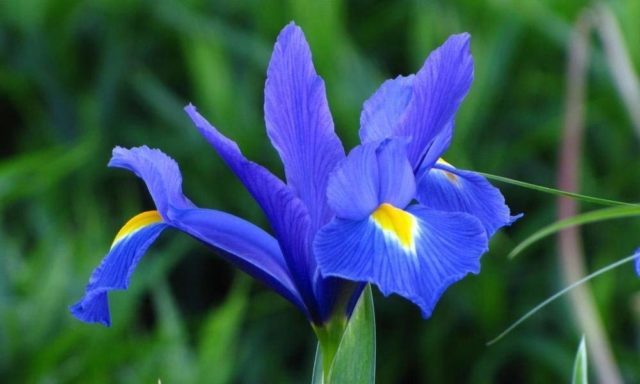
Blue Magic is one of the most beautiful and popular varieties of Dutch iris.
Dutch varieties are highly decorative and easy to grow.
Japanese
A characteristic feature of Japanese irises is the almost horizontal arrangement of the petals. Thanks to this, the buds can reach 25 cm in diameter.

Japanese iris Kogesho has an almost anemone-like flower shape
Japanese varieties grow well in high humidity.
Bulbous
Mostly irises of this type are represented by Dutch varieties. A distinctive feature is the underground part in the form of an onion. Perennials get their nutrients from it, and not directly from the soil.
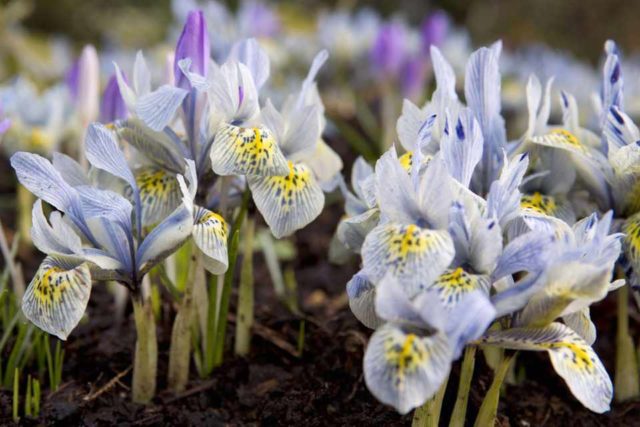
Bulbous iris Katharine Hodgkin suitable for open ground and pots
Bulbous irises are used, among other things, for growing in a flowerpot.
Siberian
Irises grow mainly in sunny meadows in the wild and are often found in Siberia. They bloom profusely and produce up to 40 small buds on a peduncle. They grow up to 70 cm, have long, slightly bluish leaves, and remain decorative for a long time - up to a month.
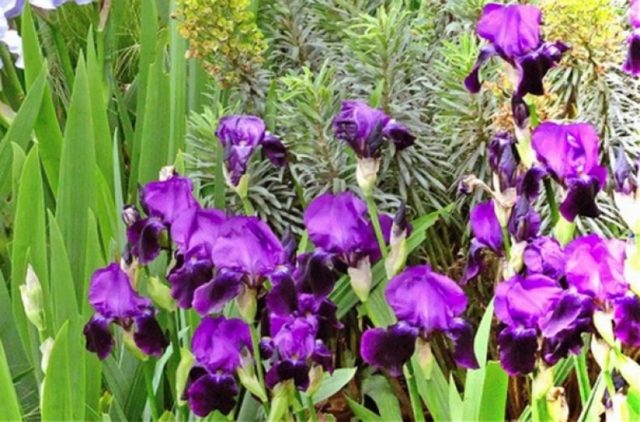
Big Ben - a beautiful cultivated variety of Siberian iris
Large varieties of irises
Perennials that rise 70-120 cm above the soil are considered large. Most often they are used in lush flower beds or used to form a high hedge inside the garden:
- Thornbird. Tall variety about 80 cm with beautiful cream buds. Blooms profusely in June and July.
Cold-resistant Thornbird is well suited for the middle zone
- Vibrant. The lush yellow iris grows up to 85 cm and bears buds of an intense golden hue.
Iris Vibrant blooms in June
- Supreme Sultan. Bicolor iris 90 cm with good winter hardiness. The upper petals of the buds are yellow-orange, and the lower ones are dark burgundy.
Iris Supreme Sultana enters the flowering period from June to July
Large varieties can be planted along fences and walls of buildings; they decorate empty space.
Low-growing varieties of irises
Dwarf perennials are considered to be those that do not rise more than 40 cm in height. One bush usually produces only 2-3 peduncles. Low-growing varieties are planted densely along paths and used as the foreground in flower beds:
- Black Cherry Delight. From June to July it bears two-colored buds - creamy at the top and with wide purple stripes on the lower petals.
Black Cherry Delight - low variety up to 30 cm
- Doll Dear. It bears yellow-green buds up to 10 cm in diameter with light blue beards. Blooms in May and June.
Dwarf variety Doll Die rises 25 cm above the ground
- Pink Custion. A miniature variety no higher than 20 cm, pink buds with an orange beard. Flowering is early - in May.
The decorative period of Pink Castion lasts 2 weeks
Border varieties of irises
Among the varieties of irises with photographs, you need to pay attention to border plants; they bloom in late May and June, and are often used to create a kind of living border in flower beds. The height is usually about 60 cm, the buds in diameter can reach 15 cm:
- Blushes. A beautiful variety with soft blue and dark blue petals, rises 65 cm above the ground.
The Blashes variety grows equally well in the sun and shade
- Realgar.Perennial about 60 cm tall with bright yellow upper and burgundy lower petals.
Realgar begins flowering in June
- Cee Jay. A variety with a blue-violet wide border along the edges of white petals in the center. Decoration occurs at the beginning of June, the height of the plant is 60 cm.
Iris CJ bears buds up to 12 cm
Border varieties are distinguished by good cold resistance and strong immunity.
Re-blooming varieties of irises
Some types of iris flowers are capable of blooming twice per season - in early summer and again in August or September. This usually happens when grown in the southern regions, where the weather is still hot at the beginning of autumn:
- Immortality. The perennial bears white buds with a yellow beard for the first time in May, and the second time at the end of August. It rises up to 80 cm above the ground.
White flowers of the iris Immortality smell very pleasant
- Jennifer Rebecca The pink iris with an orange beard grows up to 80 cm, blooms at the end of May and re-sprouts buds in August-September.
The variety Jennifer Rebecca is often used for cutting
- Mother Earth. Lilac-pink flowers interspersed with yellow in the center appear in June and again closer to autumn. The tall variety reaches 90 cm in height.
Iris Mother Earth produces up to 9 buds per peduncle
Advice! Even in warm areas, it is advisable to feed remontant irises well, otherwise you may not wait for the second flowering.
Hybrid varieties of irises
Most varieties of iris are hybrids, obtained by crossing a German species with others. They are characterized by unusual, often iridescent colors and long, abundant flowering:
- Starship Enterprise.A tall perennial about 90 cm produces buds of very original color. It is white at the top, turns yellow at the bottom, and the edges of the outer petals are purple.
Iris Starship Enterprise blooms in June and July
- Expose. An exotic hybrid with multi-colored colors - the upper petals of the iris are white, the lower petals are yellow-orange with a wide fan of blue veins. Grows up to 85 cm.
Expose iris blooms in June
- Regimen. A tall hybrid with large red flowers with a pearlescent tint. The petals are corrugated, fringed, the plant height is up to 80 cm.
The bright iris Regimen can be planted in the sun, it is not prone to fading
In total, there are over 30 thousand hybrid varieties, many of them have received international awards.
The best varieties of garden irises
It is quite difficult to objectively determine the best varietal irises; it all depends on the preferences of gardeners. But usually in this group it is customary to single out the most beautiful, unpretentious and popular perennials, whose merits are confirmed by high demand:
- Medici Prince. A light ruby iris with purple lower petals blooms in mid-summer and bears up to 14 buds on one peduncle.
Iris Prince de Medici grows up to 1 m above the soil
- Cloud Ballet. Very beautiful sky blue iris up to 90 cm tall. Blooms in May-June, remains decorative for about 3 weeks.
The Cloud Ballet variety has large flowers - up to 15 cm
- Celestial Explosion. The tall perennial produces stylish purple buds with a white and yellow beard in early summer. Dark lilac dots are scattered on the lower petals.
Celestial Explosion grows up to 90 cm
The most luxurious and beautiful varieties of iris
Several varieties deserve detailed consideration - they are rightfully considered the most luxurious. They are characterized by large buds with very rich or delicate shades.
Amethyst Flame
Amethyst Flame Iris is a tall variety, about 97 cm, that blooms in June or July. It bears very beautiful buds of a lavender, slightly purple hue. The ruffled lower petals are slightly faded in the center and decorated with silvery beards and bronze spots at the base.

The Amethyst Flame variety tolerates cold well and is suitable for the middle zone
Honorabile
Honorable Lord, or Honorabile, produces buds with a delicate lavender top and black-purple lower petals. The beards of the iris are tangerine-red, with white rays around, the flowers have a beautiful corrugated structure. The variety blooms in June-July.
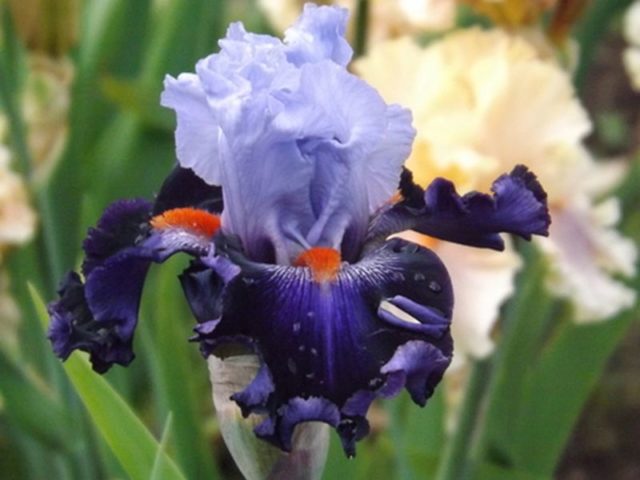
The Honorabile variety reaches a height of 90 cm
Arabian Story
Arabian Storey is a bicolor tall iris, rising up to 90 cm. The bottom of its buds are brown-burgundy, with mustard beards, and the upper part is yellow. The heavily ruffled flowers emit a sweet scent.
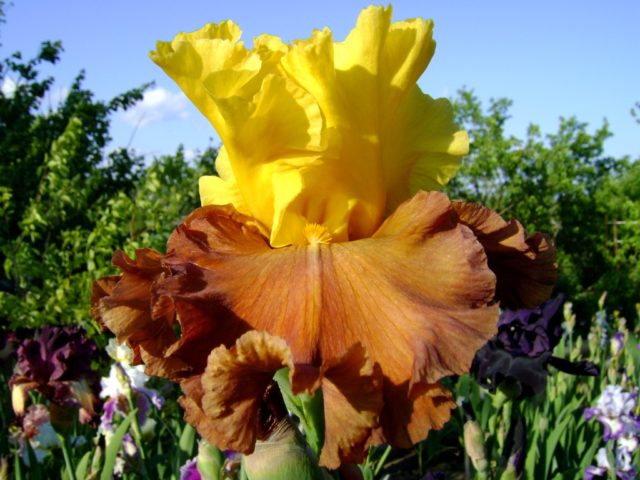
Arabian Story reaches maximum decorative potential in June
Sable night
The Sable Night variety is a tall iris up to 1 m with large flowers about 19 cm each. The buds have a double color: they are purple at the top and inky at the bottom, with a bronze beard and small light streaks around it. It becomes most decorative in June and emits the smell of sweet cocoa.

Sable night tolerates spring frosts down to -7 °C well
Stepping Out
The variety Stepping Out, or Coming Out, can grow up to 120 cm.The iris flowers are contrasting, blue-violet at the top and white with a dark lilac border at the bottom. They bloom in June and July.
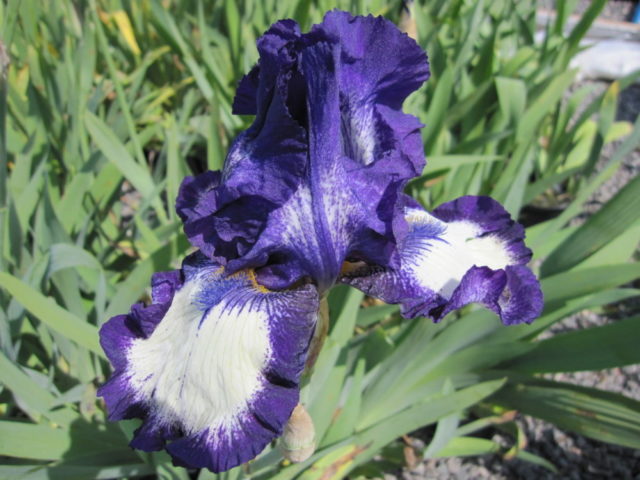
Stepping Out variety prefers sunny places to grow.
Excellency
Excellency is an impressive tall iris, about 70 cm, with a two-tone color. The upper petals of the variety are icy-lilac, light, and the lower petals are inky-purple with a blue-violet border. The beards are reddish-orange. Flowering occurs at the beginning of summer.
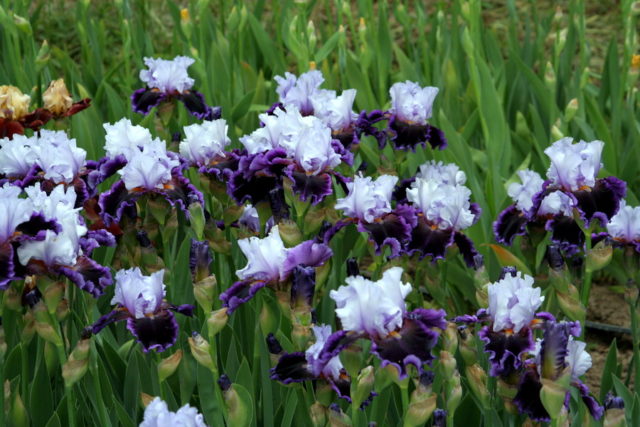
Excellence looks bright in well-lit flower beds
flavescens
Iris Flavencens is a variety with pale lemon ruffled petals and bright yellow beards. The variety is one of the oldest; it was bred back in 1813. During flowering in early summer, it emits a pleasant, refreshing aroma.
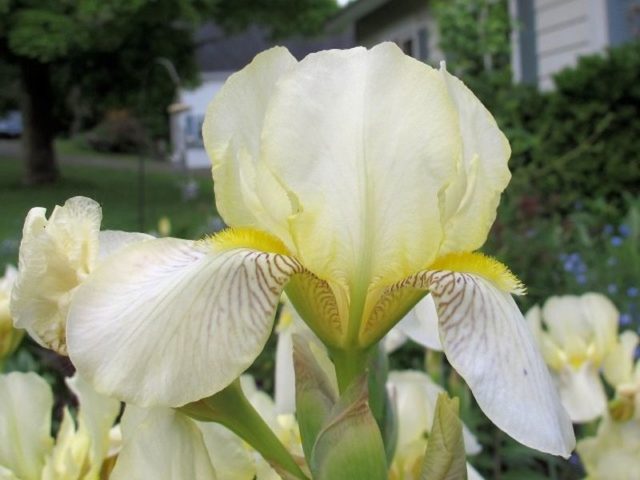
Iris flavescens looks beautiful in sunny places
Morning Mood
The tall variety Morning Mod, or Morning Mood, rises to almost 1 m and bears large buds on long stems. The petals of the iris are wavy, beige-peach on top with lavender veins, and creamy at the bottom, with a purple-red border and a golden beard. Flowering occurs in May and June and lasts about 4 weeks.
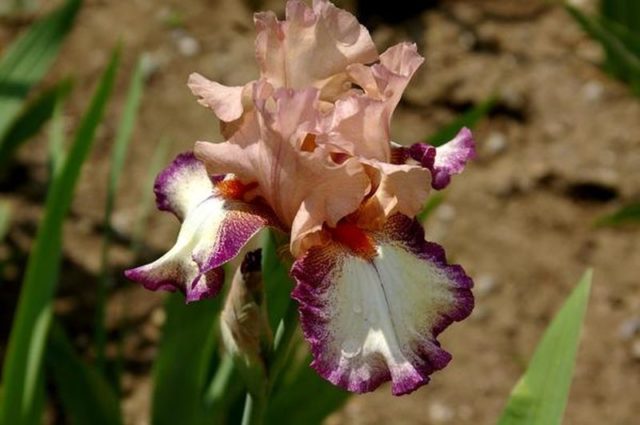
Iris Morning Mood blooms from late May
M-me Chereau
Another variety with a rich history is Madame Chéro. It was bred in 1844, but a century and a half later it still arouses interest. The small white buds of the iris have a distinct blue border on the upper and lower petals and bloom begins in late June.
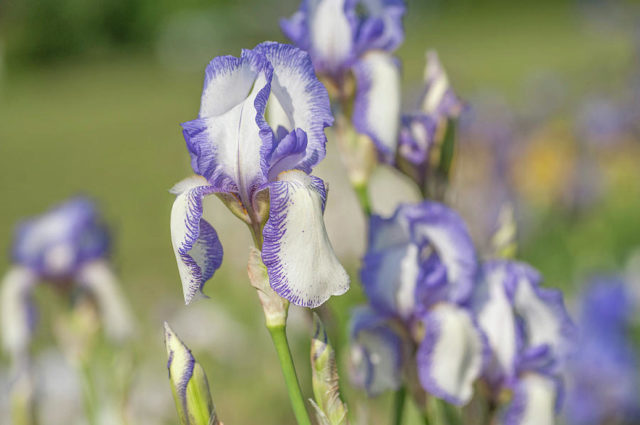
The blue border on Madame Chéro's petals is streaked and looks very artistic
Conclusion
Photos of irises of all varieties help you choose the most beautiful and interesting perennial for your summer cottage.The species diversity is represented by the most unusual shades; the plant will take pride of place in any flower bed.
